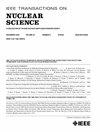Quantification and Mechanism Analysis of Total-Ionizing-Dose Effect in Top-Gate CNT FETs
IF 1.9
3区 工程技术
Q3 ENGINEERING, ELECTRICAL & ELECTRONIC
引用次数: 0
Abstract
The total-ionizing-dose (TID) effect in p-type top-gate carbon nanotube field-effect transistor (CNT FET) under顶栅碳纳米管场效应管中总电离剂量效应的量化及机理分析
通过实验和模拟研究了p型顶栅碳纳米管场效应晶体管(CNT FET)在导通、关断、透射栅极(TG)和All-0偏置条件下的总电离剂量(TID)效应。电应力的持续施加会引起碳纳米管场效应管器件特性的退化,而TID效应的叠加使其进一步复杂化。本文通过对比实验区分了电应力影响和TID效应,并利用计算机辅助设计(TCAD)技术模拟分析了这两种效应的潜在机制。实验结果表明,这两种效应对碳纳米管场效应管的影响主要是导致阈值电压偏移。电应力导致$\Delta V_{\text {th}}$在−0.1 V(关闭状态)到+0.2 V(打开状态)之间,而TID效应导致$\Delta V_{\mathbf {th}}$在−0.15 V (TG状态)到−0.05 V(打开和关闭状态)之间。TG状态被认为是碳纳米管场效应中TID效应的最坏情况。TCAD模拟结果表明,电应力激发了栅极介质层中陷阱电荷密度($\sim 10^{12}$ cm−2)的变化,而TID效应增加了衬底氧化物中的正电荷($\sim 10^{11}$ - $10^{12}$ cm−2)。本研究解释了碳纳米管场效应管中电应力和TID效应的机理,为后续器件工艺优化和辐射硬化提供参考。
本文章由计算机程序翻译,如有差异,请以英文原文为准。
求助全文
约1分钟内获得全文
求助全文
来源期刊

IEEE Transactions on Nuclear Science
工程技术-工程:电子与电气
CiteScore
3.70
自引率
27.80%
发文量
314
审稿时长
6.2 months
期刊介绍:
The IEEE Transactions on Nuclear Science is a publication of the IEEE Nuclear and Plasma Sciences Society. It is viewed as the primary source of technical information in many of the areas it covers. As judged by JCR impact factor, TNS consistently ranks in the top five journals in the category of Nuclear Science & Technology. It has one of the higher immediacy indices, indicating that the information it publishes is viewed as timely, and has a relatively long citation half-life, indicating that the published information also is viewed as valuable for a number of years.
The IEEE Transactions on Nuclear Science is published bimonthly. Its scope includes all aspects of the theory and application of nuclear science and engineering. It focuses on instrumentation for the detection and measurement of ionizing radiation; particle accelerators and their controls; nuclear medicine and its application; effects of radiation on materials, components, and systems; reactor instrumentation and controls; and measurement of radiation in space.
 求助内容:
求助内容: 应助结果提醒方式:
应助结果提醒方式:


